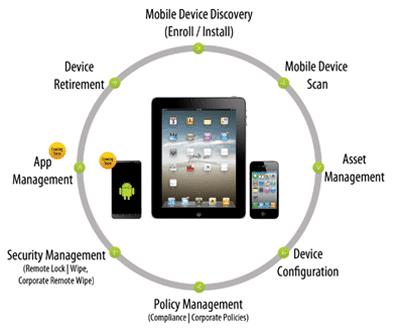Sales: 678.967.3854
Support: 866.252.6363
What We Do
Who We Serve
Success Stories
Latest Thinking
LATEST THINKING
About Us

 With 74 percent of organizations either using or planning to adopt BYOD*, (bring your own device), the days of companies issuing corporate devices are coming to an end. In fact, Gartner predicts that by 2017, half of employers will actually require personnel to provide their own devices.
With 74 percent of organizations either using or planning to adopt BYOD*, (bring your own device), the days of companies issuing corporate devices are coming to an end. In fact, Gartner predicts that by 2017, half of employers will actually require personnel to provide their own devices.
If enterprise mobility is no longer defined (and secured) by device selection, what does the future of mobility look like? Increasingly, progressive organizations are moving away from a model where employees access a handful of corporate assets (most commonly mobile email) on their smartphones. Rather, as we discussed in our recent article, “Moving Your Business to the Cloud: Three Top Reasons Why the Time Is Now,” true corporate mobility, today, affords secure employee access to a much broader array of corporate resources on any device, at any place and at any time.
To support full mobile productivity, companies now enable users to access and work with data, email and productivity applications. In other words, a district manager should be able not only to view an Excel spreadsheet but also to run analytics on it and generate a report. A salesperson should be able to pull up a contract on his or her tablet and allow a customer to sign it, onscreen, and then submit it to the finance department for processing with a single click.
These types of activities foster significant productivity gains, but they also require organizations to engage in effective application and content management, and to secure both email and productivity applications. In this environment, and especially with BYOD in the picture, the blanket approach to securing an entire device simply doesn’t work.
Rather, such an environment requires companies to take a much more granular approach to mobility management. To assist in this effort, specialized Enterprise Mobility Management (EMM) tools have been developed. They allow organizations and/or their IT partners to manage and secure mobile and cloud-based (software as a service, or SaaS) apps and their data, and to encrypt and protect all data transfers between a device and the corporate network and servers. These tools also allow organizations to create and apply policies selectively based on type of user (e.g. employee or contractor), job description and requirement, level of authority and many other variables.
This maturation of enterprise mobility is enabling worker behaviors most of us wouldn’t have dreamed were possible only 10 years ago. In the most advanced mobility deployments, retail employees roam around stores, using tablets to provide inventory checks for customers and then taking payments for merchandise on the tablet, as well. Doctors consult and update medical records from the bedside of a patient. Technicians receive text alerts on their smartphones when company equipment experiences a problem and adjust their schedules to address the issue more quickly.
These are only a few examples of what mobility is doing for the workplace, today. The new era of mobility is incredibly exciting, and here at DynaSis, we are delighted to be part of it.
*Tech Pro Research, 2015
